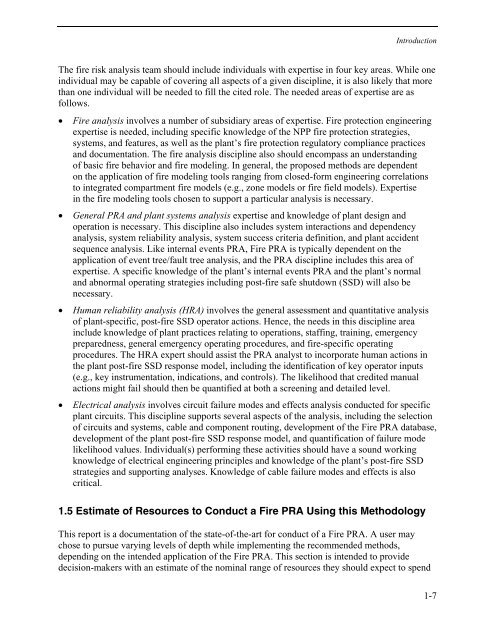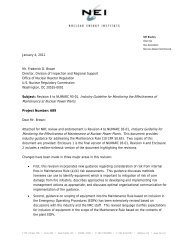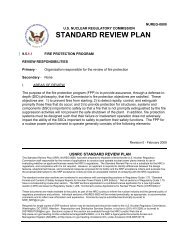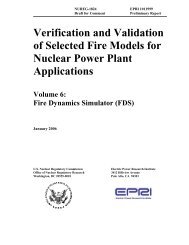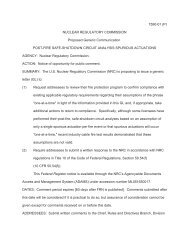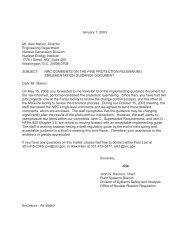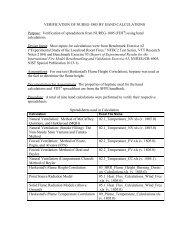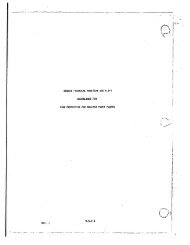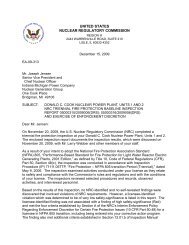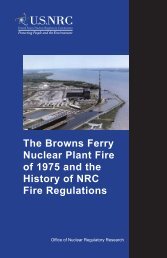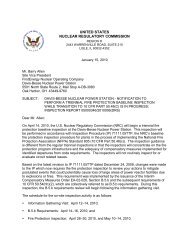NUREG/CR-6850, Volume 1 - NRC
NUREG/CR-6850, Volume 1 - NRC
NUREG/CR-6850, Volume 1 - NRC
You also want an ePaper? Increase the reach of your titles
YUMPU automatically turns print PDFs into web optimized ePapers that Google loves.
IntroductionThe fire risk analysis team should include individuals with expertise in four key areas. While oneindividual may be capable of covering all aspects of a given discipline, it is also likely that morethan one individual will be needed to fill the cited role. The needed areas of expertise are asfollows.• Fire analysis involves a number of subsidiary areas of expertise. Fire protection engineeringexpertise is needed, including specific knowledge of the NPP fire protection strategies,systems, and features, as well as the plant’s fire protection regulatory compliance practicesand documentation. The fire analysis discipline also should encompass an understandingof basic fire behavior and fire modeling. In general, the proposed methods are dependenton the application of fire modeling tools ranging from closed-form engineering correlationsto integrated compartment fire models (e.g., zone models or fire field models). Expertisein the fire modeling tools chosen to support a particular analysis is necessary.• General PRA and plant systems analysis expertise and knowledge of plant design andoperation is necessary. This discipline also includes system interactions and dependencyanalysis, system reliability analysis, system success criteria definition, and plant accidentsequence analysis. Like internal events PRA, Fire PRA is typically dependent on theapplication of event tree/fault tree analysis, and the PRA discipline includes this area ofexpertise. A specific knowledge of the plant’s internal events PRA and the plant’s normaland abnormal operating strategies including post-fire safe shutdown (SSD) will also benecessary.• Human reliability analysis (HRA) involves the general assessment and quantitative analysisof plant-specific, post-fire SSD operator actions. Hence, the needs in this discipline areainclude knowledge of plant practices relating to operations, staffing, training, emergencypreparedness, general emergency operating procedures, and fire-specific operatingprocedures. The HRA expert should assist the PRA analyst to incorporate human actions inthe plant post-fire SSD response model, including the identification of key operator inputs(e.g., key instrumentation, indications, and controls). The likelihood that credited manualactions might fail should then be quantified at both a screening and detailed level.• Electrical analysis involves circuit failure modes and effects analysis conducted for specificplant circuits. This discipline supports several aspects of the analysis, including the selectionof circuits and systems, cable and component routing, development of the Fire PRA database,development of the plant post-fire SSD response model, and quantification of failure modelikelihood values. Individual(s) performing these activities should have a sound workingknowledge of electrical engineering principles and knowledge of the plant’s post-fire SSDstrategies and supporting analyses. Knowledge of cable failure modes and effects is alsocritical.1.5 Estimate of Resources to Conduct a Fire PRA Using this MethodologyThis report is a documentation of the state-of-the-art for conduct of a Fire PRA. A user maychose to pursue varying levels of depth while implementing the recommended methods,depending on the intended application of the Fire PRA. This section is intended to providedecision-makers with an estimate of the nominal range of resources they should expect to spend1-7


